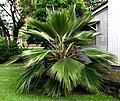Top Qs
Timeline
Chat
Perspective
Trachycarpeae
Tribe of palms From Wikipedia, the free encyclopedia
Remove ads
Trachycarpeae is a tribe of palms in subfamily Coryphoideae of the plant family Arecaceae.[1][2] It has the widest distribution of any tribe in Coryphoideae and is found on all continents (except Antarctica), though the greatest concentration of species is in Southeast Asia.[3] Trachycarpeae includes palms from both tropical and subtropical zones; the northernmost naturally-occurring palm is a member of this tribe (Chamaerops humilis).[4] Several genera can be found in cultivation in temperate areas, for example species of Trachycarpus, Chamaerops, Rhapidophyllum and Washingtonia.[5]
Remove ads
Description
Palms in this tribe have palmate leaves with induplicate folds (reduplicate in Guihaia).[3] Plants may be tall, single-stemmed trees (e.g. Copernicia, Brahea, Pritchardia), acaulescent with short, squat trunks (e.g. Maxburretia, Johannesteijsmannia), multi-stemmed (e.g. Rhapis, Acoelorraphe) or branched and prostrate (e.g. Serenoa). These palms flower regularly throughout their lives (pleonanthic) and may be dioecious, monoecious or hermaphroditic.[3]
Remove ads
Taxonomy
Summarize
Perspective
Trachycarpeae is one of eight tribes in the subfamily Coryphoideae.[6] The tribe is monophyletic, but phylogenetic studies have yet to reveal its closest relatives, though they could be the Phoeniceae, or the Sabaleae and Cryosophileae.[3] Initially described as tribe 'Livistoneae', the name Trachycarpeae has priority.[3] In previous classifications, all the members of this tribe were included in tribe Corypheae.[7]
Trachycarpeae is divided into two subtribes: Rhapidinae have flowers with three separate carpels, whereas in subtribe Livistoniinae the flower carpels are free at the base, but the styles are fused together.[3] All genera in Rhapidinae are native to the Old World, except North American Rhapidophyllum. Livistoninae are widely distributed in both the New World and Southeast Asia and Australia. A single species (Livistona carinensis) has its main area of distribution in Africa, with Chamaerops humilis extending into northern Africa. Several genera in this tribe have yet to be allocated to a subtribe, due to a lack of convincing data from phylogenetic studies.[6]
- Chamaerops - (1 sp., C. humilis, Mediterranean)
- Guihaia - (3 spp., China, Vietnam)
- Trachycarpus - (11 spp., Himalayas, Indochina)
- Rhapidophyllum - (1 sp., R. hystrix, Southeast USA)
- Maxburretia - (3 spp., Malay Peninsula)
- Rhapis - (11 spp., Indochina, Sumatra)
- Livistona - (approx. 27 spp., Southeast Asia, Australia, NE Africa)
- Licuala - (167 spp., Southeast Asia)
- Lanonia - (13 spp., Indochina)
- Johannesteijsmannia - (4 spp., Malaysia, Indonesia)
- Pholidocarpus - (6 spp., Malaysia, Indonesia)
- Saribus - (9 spp., Philippines to New Caledonia)
- Acoelorraphe - (1 sp., A. wrightii, Caribbean)
- Serenoa - (1 sp., S. repens, Southeast USA)
- Brahea - (approx. 10 spp., Mexico & Guatemala)
- Colpothrinax - (3 spp., Central America & Cuba)
- Copernicia - (21 spp., Caribbean, South America)
- Pritchardia - (approx. 27 spp., Pacific)
- Washingtonia - (2 spp., California, Mexico)
The above classification was published prior to the recognition of the genera Saribus and Lanonia; however, both are clearly members of subtribe Livistoniinae. Saribus includes species formerly in Livistona and monotypic Pritchardiopsis,[8] while Lanonia species were previously included in Licuala.[9][10]
Remove ads
Gallery
- Guihaia grossefibrosa
- Pritchardia martii
- Rhapis humilis
References
Wikiwand - on
Seamless Wikipedia browsing. On steroids.
Remove ads

















